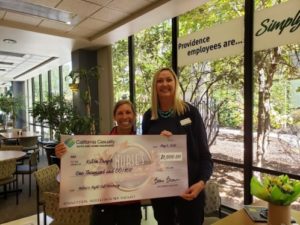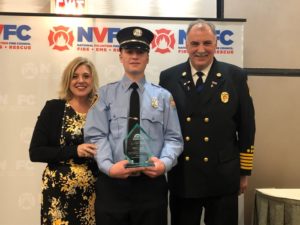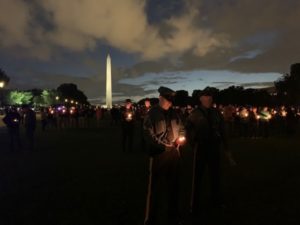by California Casualty | Health |
Summer is here and it is the perfect time to take a vacation. However, many people think they are either too busy for or simply don’t need to take time off during the year; but getting away is actually beneficial to both your physical and mental well-being.
So, stop making excuses and consider these five reasons why need to take a vacation this summer:
- Relax and Recharge- Sometimes you simply need to recharge your batteries. When you’re busy all the time, you can really wear yourself out; but taking a trip can increase your energy levels so you’re ready for a fresh start when you get back.
- Stimulates Your Brain- Giving your brain a break from daily life allows it a chance to reboot. Relaxing also helps your brain function. When it’s not focusing on all of your normal tasks at work, your brain can also discover and learn new things.
- Improves Physical Well-being- Skipping vacation and not taking time for yourself can increase stress levels and decrease energy levels, which leads to being mentally and physically burnt out. The effects of work-stress and fatigue can also weaken your immune system, making you more vulnerable to sickness.
- Boosts Your Mental Health-Taking a vacation and being on your own schedule is a great way to get out of a slump and find motivation again. The time off gives you change in perspective and can help get your mind back in the right place; and you’ll likely sleep better not thinking about work all of the time.
- Makes You More Productive-Working long hours and constantly busying yourself could cause a decline in work quality and performance. So, it’s no surprise that taking a few day break may help improve your performance and increase productivity.
Don’t sweat missing a few days of work, remember, it will always be there when you get back. Whether you decide travel cross-country or plan a stay-cation, you’ll feel rejuvenated and ready to take on anything when you return. So, load up the kids, pack on the sunscreen, turn on our “Kid-Friendly Summer Road Trip” playlist on Spotify, and hit the road.
Happy Travels!

by California Casualty | Calcas Connection, In Your Community |
You always amaze us. From great achievements, awards, and celebrations, you impress us with all of your many accomplishments. We’ve been lucky to be there with you for many of them.

California Casualty contingent and California Superintendent of Public Instruction, Tony Thurmond, celebrating Distinguished Schools with Mickey and Minnie Mouse
On the education side, California Casualty is proud to sponsor the California Distinguished Schools Awards and Gala. It was a thrilling night at Disneyland in April, as we honored the 162 public middle and high schools and 18 districts that were named 2019 Distinguished Schools and Exemplary Districts.
California Superintendent of Public Instruction, Tony Thurmond, thanked California Casualty for its help. “We couldn’t provide this platform of acknowledgement without our partnership with California Casualty, a long-time sponsor of our California School Recognition Program,” he said.

Nina Ericksen presenting the Distinguished School banner to Medea Creek Middle School
Our CEO, Beau Brown, expressed how fortunate we were to be a part of the special event. “We are elated to join the Department of Education, California Teachers Association and the Association of California School Administrators in congratulating all of the schools and districts being honored, especially the dedicated staff who worked so hard for this designation. Their dedication and innovative leadership has helped California continue to be one of the top states preparing students for graduation, college and beyond.”
The entire list of 2019 California Distinguished Schools can be found at www.cde.ca.gov/ta/sr/cs/yr19distschools.asp.

Meadville High Athletics Grant presentation

Athletics Grant presentation at Lewis
Middle School
Also in April, we announced the 64 public middle schools and high schools in 32 states that were recipients of the 2019 Thomas R. Brown Athletics Grants. A total of $67,149 was awarded this year to help schools affected by tight budgets purchase equipment, improve safety or provide new uniforms. A couple examples included Lewis Middle School in CA, where the grant will help provide uniforms that will be shared by the basketball, cross country and Special Olympics teams, and Meadville Area High School in PA, where the baseball team will buy safety equipment and update the scoreboard.
The entire list of 2019 Thomas R. Brown Athletics Grants awardees can be found on the California Casualty newsroom page, www.calcas.com/-/64-schools-cross-the-finish-line-with-a-2019-athletics-grant-from-california-casualty.

Caden receiving his Create Real Impact award
California Casualty is also a proud supporter of the Create Real Impact Contest, which awards students ages 14-22 for their creative works to spread the word about the dangers of distracted driving. Educational Grants totaling $12,000 were awarded in the 2019 Spring contest, including Caden Turner’s $1,500 grand prize for his video, “Listen Up.” The Missouri teen was honored during a district school board meeting in April.
Other grand prize recipients were:
- Ashlee Walkowiak, WI, in the writing category for her work titled, “Be Different”
- Everen Graves, CA, in the music category for the song “So Much to Live For”
- Lindsey Sanchez, GA, in the art category for the poster “Camera Filters”
Information about the Create Real Impact Contest and the Spring 2019 winners can be found at www.createrealimpact.com.

Karen and Field Marketing Manager DeeDee Tempeleton
And because nurses give so much, California Casualty gives back with the $1,000 Nurse’s Night Out award. Medford, Oregon ICU nurse Karen Dwyer was the most recent winner. At the check presentation in May, Karen said she will use the funds to buy a new bicycle for an upcoming cross country bike trip. “It makes me feel good to receive this honor, and it’s a wonderful way to show appreciation for the caring we give to people – especially as we start Nurses Week,” she said.
Oregon & Ohio nurses can apply for the next Nurse’s Night Out at www.nursesnight.com.

Tanya and NVFC’s Bob Timko with Jr. Firefighter recipient Robert Dowd
California Casualty has worked with firefighter organizations since 1974. We’ve provided support for various trainings, benefits and activities, as well as Firehouse Makeovers and Work Hard/Play Hard giveaways.
An important program that California Casualty sponsors is the National Volunteer Fire Council’s annual Junior Firefighter and Junior Firefighter Program of the Year Awards. The 2019 recipients are Robert Dowd and the Westport, Massachusetts Fire Department’s Explorer Post #744. California Casualty’s Account Relations Manager, Tanya Rigsby, helped present Robert’s award at the NVFC awards gala at the end of April. Robert remarked that it was nice to be recognized for the hard work he’s put into the fire service, and how important it is that California Casualty helps in the effort to develop future fire professionals. “The support that I have received from California Casualty has been unparalleled, and it has pushed me harder to be my best and helped me focus on reaching future goals that will put me at an advantage in life,” he said.
We also ask a lot from our law enforcement officers, with all too many losing their lives as they do their jobs. It is important that we remember and honor those who give the ultimate sacrifice.

National Law Enforcement Memorial Ceremony
California Casualty was proud, once again, to attend the National Law Enforcement Memorial and help sponsor the National Association of Police Organizations (NAPO) TOP COPS awards.
Vice President of Partner Relations, Roxanne Dean, and Alina Fayerman, Account Relations Manager, represented the company as family, friends and the public honored 371 fallen officers from 2018 at the nation’s capital.
Roxanne and Alina were also present as the TOP COP Awards were presented to law enforcement officers from 10 federal, state, county, tribal and local agencies from across the country, for actions from the previous year that went above and beyond the call of duty.
California Casualty salutes the law enforcement officers for all the work they do to make a difference for their communities.
You all do extraordinary things, and California Casualty continues to thank you for your hard work. Educators have until June 30 to apply for a Music and Arts Grant at www.calcasmusicartsgrant.com, and until July 12 for a $7,500 School Lounge Makeover at www.NewSchoolLounge.com. First responders can enter to win a $7,500 Garage Makeover from California Casualty at www.Contest4Heroes.com. Pass the information on to your colleagues too. The entry deadline is October.
TAKEAWAY:
Learn more about the many resources and ways we honor the professions we serve at our blog, https://mycalcas.com.
by California Casualty | Calcas Connection, Consider This |
When something happens to your vehicle, it’s an unexpected and unappreciated disruption to your life. We often take for granted the convenience our vehicle provides – until it is out of commission following an accident or other covered claim. That’s why you need rental car reimbursement.
Rental car reimbursement, also known as rental car coverage or transportation expense, is a wonderful feature of your auto insurance. When added to your policy that already has collision and comprehensive, it pays the cost of renting a vehicle until repairs from a covered accident or loss are completed on your ride.
Did you know?
- Insurance will only reimburse you for the daily rental rate. Other expenses, such as the cost of gas or security deposit for the car, are typically your responsibility.
- The rental car company can bill the insurer directly if you choose one that partners with your insurer.
- Lower rental rates are available to those involved in an accident, but you must let the rental agent know that you are renting due to an accident.
- There are typically two types of parameters for reimbursing your temporary rental: a daily rate and a per-claim limit.
- Choosing the right amount of rental reimbursement is important. Some insureds may need only the minimum coverage amount while others may need more.
If you have a large family that requires a larger SUV or van to commute to work, school and all of the extracurricular events your family participates in, then you should consider a higher amount of rental car reimbursement. Also, take into account where you live. What are the going rates for a rental car, truck or SUV that would fit your needs should your personal vehicle be out of commission for a number of days? Be sure you have the limits that make sense for your needs.
An accident is disruptive enough; having the right rental reimbursement coverage will save you time, money and headaches while you’re getting your vehicle back on the road.
TAKEAWAY:
A California Casualty advisor is ready to give you a policy review, make sure that you have comprehensive and collision coverage, and check the amount you have for rental car reimbursement. Give a call today at 1.800.800.9410 option 3, or visit www.calcas.com/customer-service.











